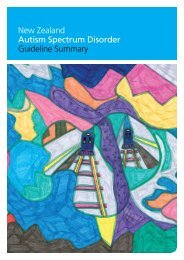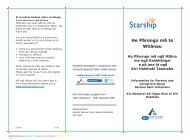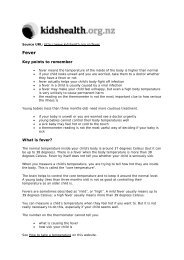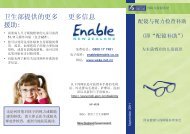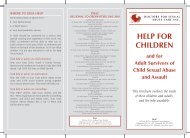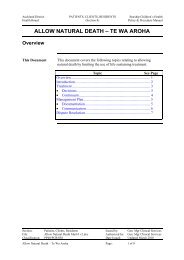New Zealand Autism Spectrum Disorder Guideline - Ministry of Health
New Zealand Autism Spectrum Disorder Guideline - Ministry of Health
New Zealand Autism Spectrum Disorder Guideline - Ministry of Health
Create successful ePaper yourself
Turn your PDF publications into a flip-book with our unique Google optimized e-Paper software.
Part 3: Education for learners with ASD<br />
for communication 96 189 . Many children with<br />
ASD find visual quasi-symbols, such as photos<br />
and pictograms which are more static, easier to<br />
comprehend than verbal language 96 213 .<br />
5. Social pragmatic skills<br />
Communication interventions have traditionally<br />
focused on unusual aspects <strong>of</strong> speech, such<br />
as echolalia (imitating the speech <strong>of</strong> others),<br />
pronoun reversal and unusual intonation. More<br />
recent research has emphasised the functional<br />
aspects and social or pragmatic aspects <strong>of</strong><br />
communication, such as sharing attention (joint<br />
attention) or using and noticing non-verbal cues<br />
such as gestures and facial expressions 96 .<br />
Children and young people who develop fluent<br />
speech may still have difficulty with social<br />
rules governing conversation 96 . Difficulties with<br />
prosody, which includes rate, rhythm, inflection<br />
and volume, also provide challenges which need<br />
to be addressed 214 .<br />
6. Echolalia<br />
Children with ASD who learn to talk <strong>of</strong>ten<br />
use echolalia as they start to communicate 96 .<br />
Echolalia can be immediate (ie, an echo <strong>of</strong><br />
something just spoken) or delayed (ie, refer to<br />
an event in the past). This speech initially serves<br />
as a label for a particular situation but may at<br />
later stages serve a variety <strong>of</strong> communicative<br />
functions 215 . Many children eventually learn<br />
to break these scripts down into smaller, more<br />
meaningful chunks 189 . Even after children<br />
have developed more fluent speech, echolalia<br />
may reappear when the child is confused or<br />
fatigued 215 .<br />
7. Unconventional behaviours<br />
Children who do not develop fluent<br />
communication skills may use inappropriate<br />
or unconventional behaviours such as<br />
tantrums, aggression or self-injury as<br />
means <strong>of</strong> communication. Improvements in<br />
communication have been found to be a key<br />
factor in improving and preventing problem<br />
behaviours 96 189 .<br />
There is strong support for functional<br />
communication training – where the<br />
communicative function <strong>of</strong> a behaviour is<br />
identified and an appropriate communication<br />
form (including signs, visual symbols or<br />
language) is taught as an alternative to the<br />
challenging behaviour. This intervention has<br />
the advantage <strong>of</strong> teaching the individual to<br />
communicate, as well as reducing undesirable<br />
behaviours 96 189 192 213 (this is discussed in more<br />
detail in section 3.2.e: Self-management skills and<br />
addressing challenging behaviour).<br />
Approaches to interventions<br />
In the 1970s and 1980s, the developmental<br />
pragmatic literature which looked at the<br />
development <strong>of</strong> communication for social<br />
purposes began to influence interventions for<br />
children with ASD 192 .<br />
Speech is only one form <strong>of</strong> communicating,<br />
but in the past it has been seen as the main<br />
focus for intervention for children with ASD 55 .<br />
However, without a good understanding <strong>of</strong><br />
the social purpose <strong>of</strong> communication, the child<br />
may never make use <strong>of</strong> the words they learn to<br />
communicate with others 192 .<br />
Most children understand a lot about<br />
communicating before they learn to speak<br />
and it is equally important for children with<br />
ASD to develop this pre-verbal knowledge.<br />
Very young typically developing children<br />
begin to communicate using informal means<br />
such as gestures – for example, raising their<br />
arms to be picked up, or pointing. Young<br />
children with ASD may have a limited<br />
range or unconventional gestures for their<br />
communication. They are likely to use<br />
communication to regulate another person’s<br />
behaviour, such as requesting something by<br />
taking someone’s hand and leading them to the<br />
object, and they are less likely to use the more<br />
socially oriented functions such as pointing to<br />
draw another person’s attention to something 215 .<br />
Part 3<br />
<strong>New</strong> <strong>Zealand</strong> <strong>Autism</strong> <strong>Spectrum</strong> <strong>Disorder</strong> <strong>Guideline</strong> 97



